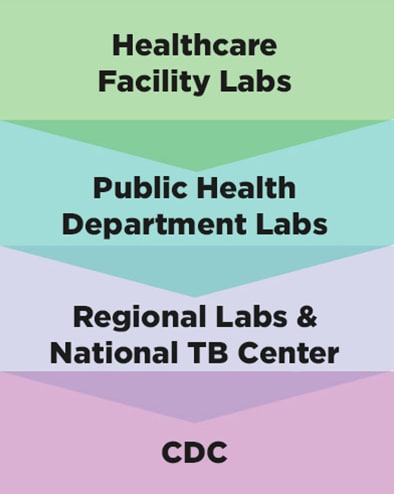How Labs Work Together


The AR Lab Network process enhances collaboration for a more rapid response to detect resistance.
CDC’s Antimicrobial Resistance Laboratory Network (AR Lab Network) is an effort between U.S. healthcare facility labs and public health department labs, regional labs and the National TB Center, and CDC. Laboratories nationwide work together to rapidly identify antimicrobial-resistant genes and germs that could cause hard-to-treat or potentially untreatable infections. Collaboration from the local to national levels results in more rapid response for detecting resistance.
- Establishes protocols that immediately notify the health department, healthcare provider, and infection control staff of unusual resistance
- Works with public health department to understand when and where to submit isolates or specimens for testing
When healthcare or clinical labs suspect Carbapenem-resistant Enterobacterales (CRE) or carbapenem-resistant Pseudomonas aeruginosa (CRPA), they send the isolates (pure samples of a germ) to the public health department labs, also known as jurisdictional labs. Benefits of submitting isolates include, for example, obtaining resistance mechanism data and detecting patient outbreaks.
- Works with healthcare facilities to provide timely lab results and recommendations, and alert them if a patient with resistance came from or was transferred to another facility
- Reports unusual resistance when identified to regional labs and CDC, develops a plan to rapidly respond, and coordinates with the affected healthcare facilities, regional lab, and CDC
When a public health department lab receives CRE and CRPA isolates from a healthcare facility lab, the public health lab confirms the bacterial species identity and performs additional testing (susceptibility or molecular testing) to characterize the isolates.
In addition to CRE and CRPA, every state health department lab can test for enteric (gut) bacteria like Salmonella.
When public health department labs identify unusual resistance, they notify CDC and can send the isolates to their regional labs for additional testing when appropriate.
- Detect existing and emerging types of antimicrobial resistance, track changes in resistance, and identify outbreaks
- Generate stronger data to protect people and combat future resistance threats
The public health department labs will send some pathogen isolates, like CRE and CRPA, to the regional labs when support is needed. For example, regional labs will perform colonization screening tests for CRE and CRPA, or an emerging fungal threat like C. auris. The AR Lab Network also receives pathogens from other CDC funded activities. The regional labs can also test Neisseria gonorrhoeae isolates from the Gonococcal Isolate Surveillance Project (GISP) and Strengthening the United States Response to Resistant Gonorrhea (SURRG) program.
The National TB Center is equipped to perform whole genome sequencing for Mycobacterium tuberculosis isolates identified in the U.S. The National TB Center receives all available isolates from the state health departments.
- Established and coordinates the AR Lab Network
- Provides technical expertise to support the network, including:
- Developing new lab tests, guidance, and tailored solutions so health departments can quickly identify new threats
- Supporting prevention experts, programs, and training in every state
- Collecting, tracking, and monitoring threats found from state and regional labs, and identifying data gaps and trends in resistance
- Reporting critical findings to international partners
The regional labs will send unusual isolates to CDC to confirm testing and conduct additional tests when needed. CDC provides recommendations for local prevention and response, and supports outbreak response when threats are reported.
CDC adds some isolates to the Antimicrobial Resistance Isolate Bank for drug and diagnostic test development.